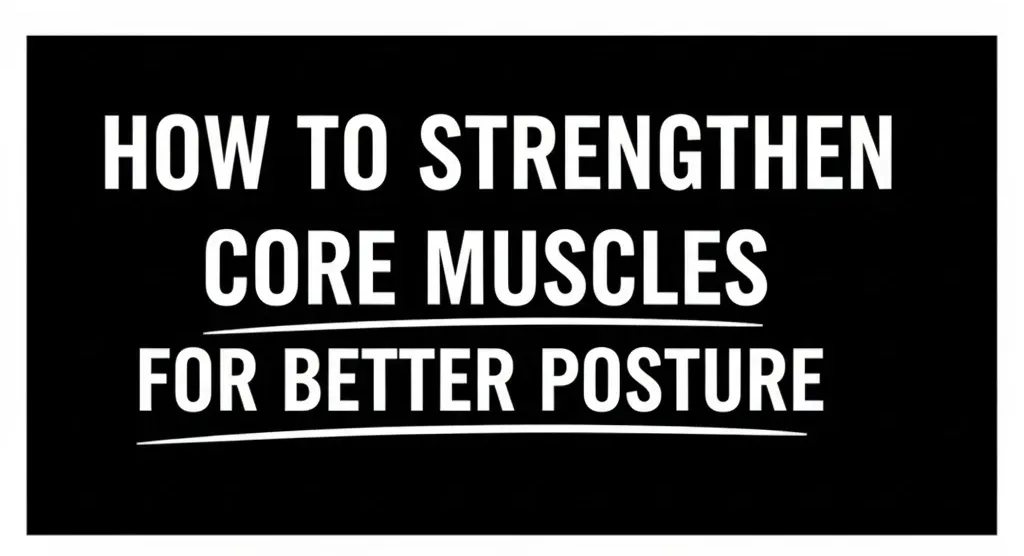A stable posture begins with strong core muscles. These muscles connect your upper and lower body, helping you move, balance, and stay upright. When they’re weak, even sitting for long hours becomes tiring, and slouching feels natural. Building strength in the core improves stability, reduces fatigue, and keeps your spine aligned. You don’t need machines or heavy training—simple daily actions and intentional exercises can build noticeable change. Here’s a complete, natural guide to developing core strength for better posture and full-body balance.
1. Recognize the Role of Core Muscles
The core isn’t limited to your stomach area. It includes muscles around the spine, lower back, hips, and abdomen. These muscles work together to support movement, balance, and breathing. Strengthening them allows your body to stand taller and move more efficiently.
2. Begin with Posture Awareness
Before training, become aware of how you sit or stand. Keep your shoulders open, chin parallel to the ground, and your abdomen slightly engaged. Maintaining this posture throughout the day keeps your core active, even without exercise.
3. Practice Foundational Core Exercises
Start with simple moves that build endurance and control. Focus on slow, steady movements that emphasize breathing and stability rather than speed.
Gentle Core Exercises for Beginners
| Exercise | Time/Reps | Benefit |
|---|---|---|
| Front Plank | 30 seconds | Improves core stability |
| Lying Leg Lift | 10 reps | Strengthens lower abs |
| Bridge Lift | 15 reps | Supports hips and back |
| Opposite Arm and Leg Raise | 10 each side | Improves coordination |
| Side Plank | 20 seconds each | Builds lateral strength |
4. Strengthen the Back and Hips Together
Strong posture depends on balanced strength. Combine abdominal work with back and hip exercises such as superman lifts and hip thrusts. This prevents uneven tension and helps maintain a neutral spine.
5. Add Movement-Based Strength
Once basic control develops, move to exercises that involve rotation and bending. Movements like torso twists or standing reaches mimic daily activities and train your body to stay stable during motion.
6. Train Through Everyday Habits
You can build a strong core without structured workouts. Tighten your abdominal muscles while walking, driving, or sitting at your desk. Standing with equal weight on both feet also activates stabilizing muscles.
Daily Habits That Support Core Strength
| Activity | How It Helps | Example |
|---|---|---|
| Walking with awareness | Engages midsection muscles | Keep shoulders relaxed and core tight |
| Standing evenly | Prevents hip imbalance | Distribute weight on both feet |
| Sitting tall | Keeps spine neutral | Avoid leaning into the chair back |
| Controlled breathing | Strengthens internal muscles | Breathe through diaphragm |
| Regular stretching | Improves mobility | Stretch hips and ribs daily |
7. Focus on Controlled Breathing
Deep, slow breathing supports the internal muscles that stabilize your spine. When you exhale and tighten your abdomen, you naturally train your core. Practicing this daily builds strength gently and safely.
8. Include Balance Workouts
Standing on one leg, using a stability ball, or practicing slow yoga poses improves balance and challenges your core from different angles. These exercises train your muscles to stabilize your body in motion.
9. Stretch for Mobility
Flexibility is as important as strength. Tight hips or hamstrings can pull your spine out of alignment. Spend five to ten minutes daily on gentle stretches that loosen your lower back and pelvis.
10. Avoid Prolonged Sitting
Sitting too long weakens your midsection and tightens hip flexors. Take breaks every hour to walk, rotate your shoulders, or stand tall for a minute.
Sample 15-Minute Core Routine
| Step | Exercise | Duration |
|---|---|---|
| 1 | Plank | 40 seconds |
| 2 | Bridge | 15 reps |
| 3 | Side Plank | 30 seconds per side |
| 4 | Bird Dog | 10 reps each side |
| 5 | Cobra Stretch | 1 minute |
11. Engage Supporting Muscles
Your thighs, glutes, and lower back work with your core to maintain balance. Include squats, side steps, and gentle lunges in your weekly routine. They enhance joint stability and posture control.
12. Use Yoga or Pilates for Core Activation
These practices strengthen deep muscles that aren’t easily reached through basic workouts. Poses like Boat, Warrior III, and Plank hold your posture while improving control and flexibility.
13. Eat for Muscle Strength
Muscles need nutrients to recover and stay active. Include eggs, leafy greens, lentils, and seeds in your diet. Natural sources of calcium and protein improve muscle tone and prevent fatigue.
14. Stay Hydrated
Water helps maintain elasticity in muscles and ligaments. Even mild dehydration can cause tightness or stiffness. Sip water regularly, especially during long work hours.
15. Get Enough Rest
Muscles rebuild and strengthen during rest. Adequate sleep improves coordination, energy, and posture awareness. Aim for steady sleep patterns to maintain long-term progress.
FAQs
1. How long does it take to build core strength?
Consistent practice for three to four weeks can noticeably improve posture and stability.
2. Can walking help strengthen my core?
Yes, walking with proper posture naturally activates abdominal and hip muscles.
3. Do I need equipment for core exercises?
No, bodyweight routines are enough to develop deep core strength.
4. Can yoga improve posture faster?
Yes, yoga builds strength and flexibility together, improving alignment effectively.
5. How does breathing affect posture?
Deep breathing strengthens internal muscles and supports spine balance.
6. Can core training relieve back pain?
A strong core reduces pressure on the spine, often easing mild back discomfort.
Conclusion
A strong core creates lasting posture, stability, and confidence. You don’t need complex routines—just daily awareness, steady effort, and a few intentional exercises. Strength grows naturally when movement and alignment work together. Over time, your spine stands taller, your balance improves, and your energy increases. Core strength isn’t built overnight but through mindful, consistent habits that support your body’s natural posture.








